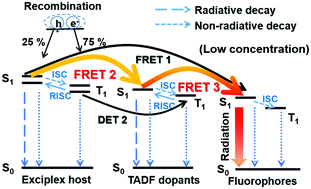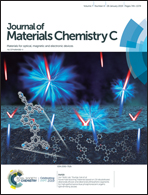Triplet exciton harvesting by multi-process energy transfer in fluorescent organic light-emitting diodes†
Abstract
Fluorescent organic light-emitting diodes (FOLEDs) have drawn considerable attention due to their advantages of low price, good device stability and good color-purity in the area of solid-state lighting. However, conventional FOLEDs in a common host–guest system usually show poor efficiency due to the limited internal quantum efficiency (IQE) of 25% according to spin statistics. Devising a method to harvest triplet excitons efficiently has been important in case of FOLEDs. Thermally activated delayed fluorescence (TADF)-sensitized FOLEDs using exciplex-forming co-hosts or TADF molecules as sensitizers are prospective for solving the above issue at a low cost. Herein, we propose novel double-dopant TADF-sensitized FOLEDs in an exciplex-forming co-host system doped with energy transfer assisted TADF molecules and fluorophores, which can help harness triplet excitons by introducing additional two Förster resonance energy transfer (FRET) processes. The EQE of the novel double-dopant TADF-sensitized FOLEDs could be enhanced to more than twice the efficiency of conventional one-dopant TADF-sensitized FOLEDs. Theoretical analysis and calculations were performed to understand the energy transfer process and explain the obtained experimental results.



 Please wait while we load your content...
Please wait while we load your content...